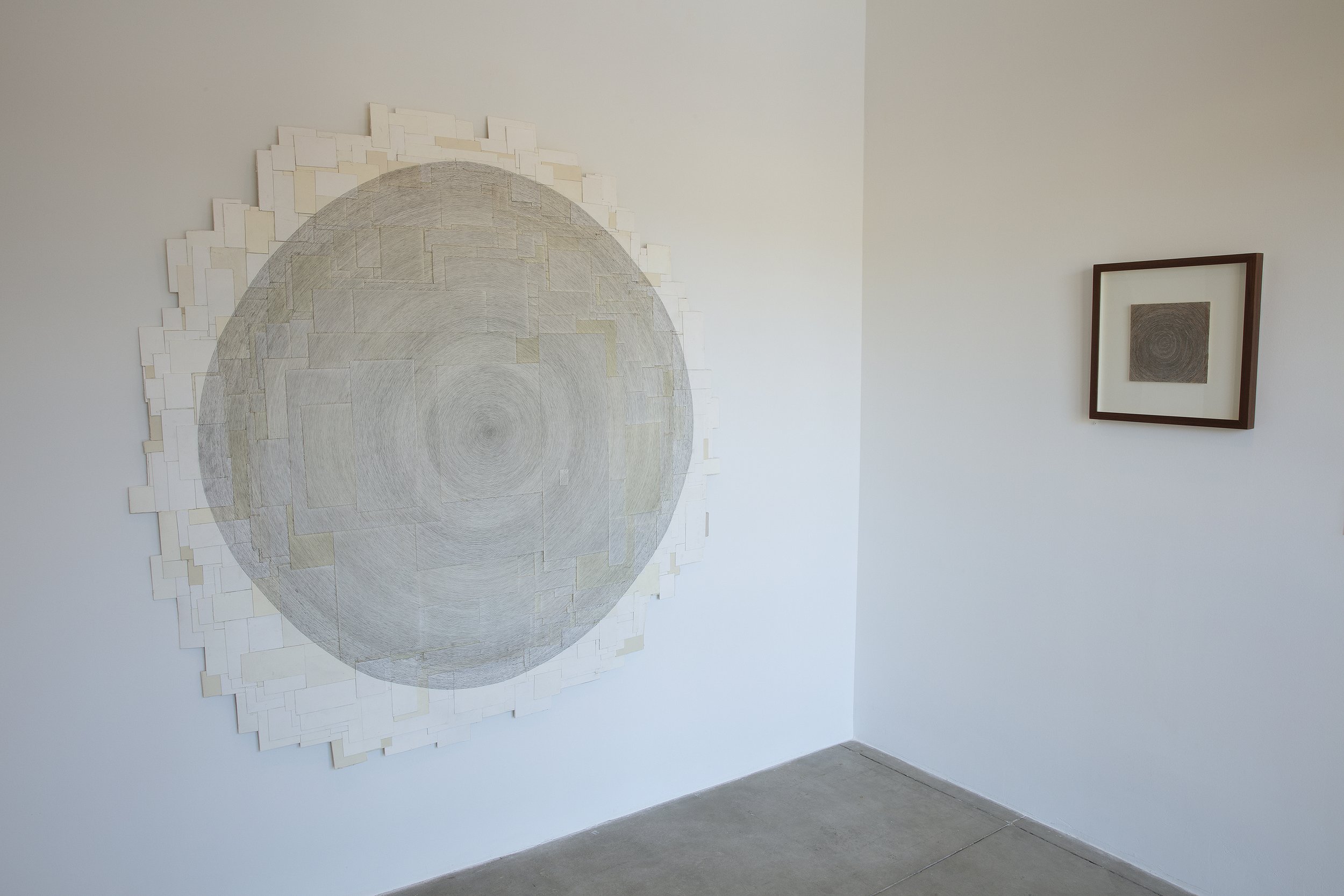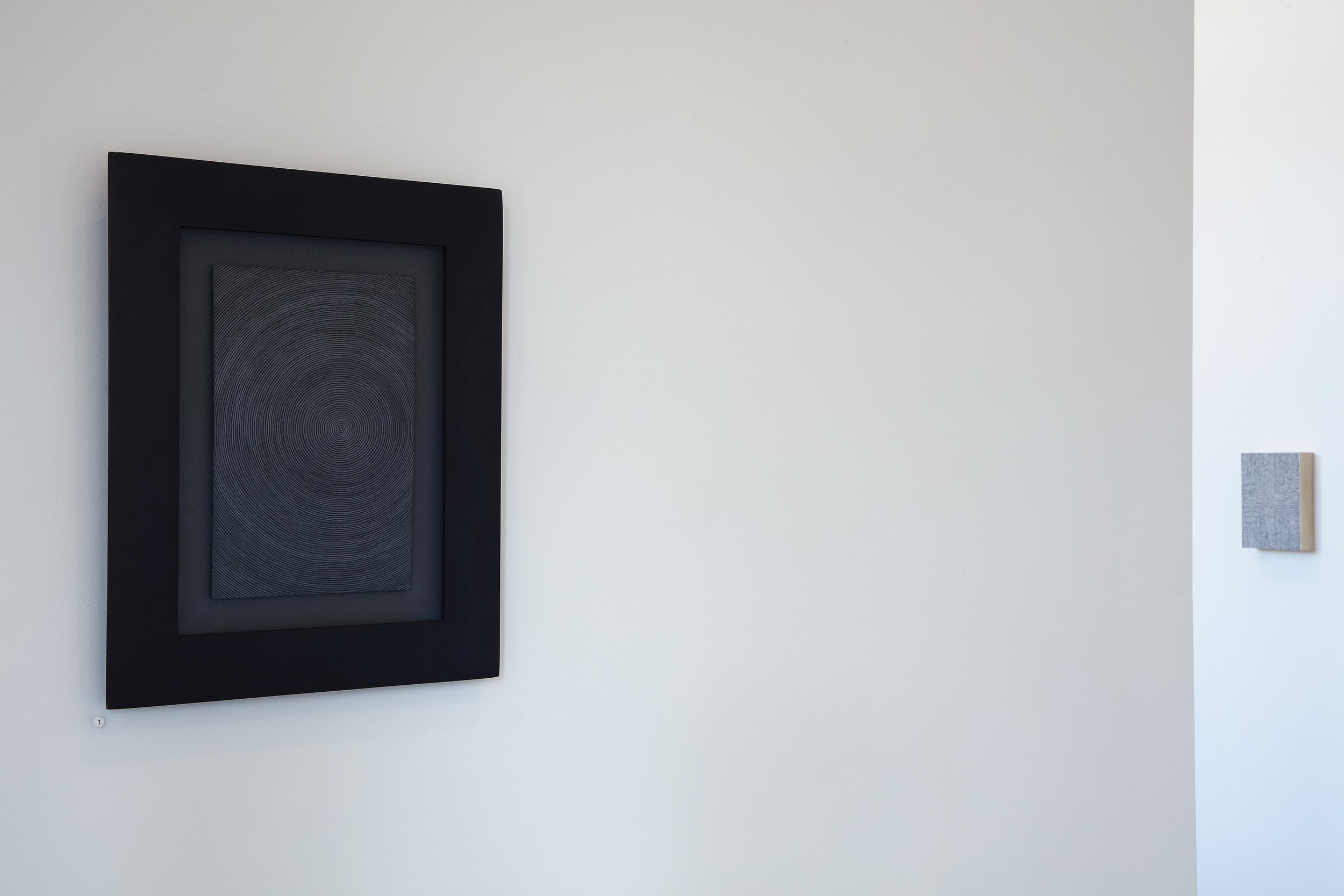OCD, drawing, 6 x 6 foot diameter, pencil on museum board, circa 1992 - 2019
By Galen Brown
Solo Exhibition runs from 1 February 2022 - 5 March 2022
Reception 12 February 3-6pm
OCD, drawing, 6 x 6 foot diameter, pencil on museum board, circa 1992 - 2019
Installation view of OCD (approx 6 foot x 6 foot), pencil on museum board, 1992-2019, and Nara Jara, wood dust and mineral spirits + pencil on museum board 8.5” x 8.5” framed 18” x 17.5”
GALEN BROWN
Galen Brown was born in Reno in 1959 and raised in both Reno and at King’s Beach, Lake Tahoe. He was a dedicated junior ski racer on the Reno Falcons ski team and later the Lake Tahoe Ski Club, and a quiet loner in school who lacked direction until a ski accident rendered him immobile for six months. He began drawing from his bed while healing.
Brown commenced classes at the San Francisco Art Institute and stayed for the duration of his formal art education, earning a bachelor’s degree in Fine Arts in 1988 and a Master of Fine Arts in 1990. He continued studying in China and New York, and for the following 20 years Brown resisted selling his work to collectors, preferring to keep his bodies of work together.
In 2019 the Nevada Museum of Art installed his solo exhibition Sine Cere, across 3 of their expansive gallery spaces.
Sine Cere, the title piece, a large 8 foot diameter circle drawing was purchased by the museum for their permanent collection.
A large body of Brown’s work was featured in Tilting the Basin, the Nevada Museum of Art survey exhibition of contemporary artists working in the state of Nevada in 2016, which also traveled to a second Museum location in Las Vegas in 2017. His work is also in the permanent collection of the Nevada Arts Council, and the newly founded Clear Creek Collection at Lake Tahoe.
The quality of Brown’s work was recognized with the prestigious Joan Mitchell Foundation artist’s award in 2017.
A fleeting visit to OCD,2 the solo exhibition of Galen Brown, 2022
Installation view of the Waves drawings and the new Small Waves drawings. Partial view of Untitled sandpaper sculpture.
Solid aluminum, metal spikes and used sandpaper circles 39” x 5.5” x 5.5” Circa 1999-2003
Untitled black circle pencil on museum board 16” x 12.” Distant view of Untitled Small Wave, 5” x 7” x 1.5” ink on museum board, mounted on aluminum, on wooden frame
Installation view of part of the Selfie series, Limited edition print, 1/5. Each 24” x 24” photographically printed on Canson etching rag cotton
Installation view of part of the Selfie series, Limited edition print, 1/5. Each 24” x 24” photographically printed on Canson etching rag cotton
OCD, 2
Essay by Josie Glassberg
Sometimes, it is difficult to talk about artwork that feels overly pure because it forces truisms that feel overly corny. I’m not afraid of corny-ness, but when I say that Galen Brown’s work blurs the line between life and art, I am worried it will sound trite, when it is simply true.
Often characterized as “meditative” or “hypnotic,” Brown’s repetitive circles and waves begin dissolving the viewer’s life-art barrier as onlookers shift from glance to trance. I first encountered this feeling with Brown’s work during his retrospective, Sine Cere, at the Nevada Museum of Art in 2019, where the artist’s oversized circle drawings presented themselves as subjects to be experienced, rather than objects to be analyzed.
Echoing the serial linework and low contrast styles of artists like Agnes Martin and Eva Hesse, Brown’s drawings and paintings functioned, for me, as portals into a tranquil state of mind. Instead of observing the artist’s painstaking marks or wondering how many years it took the artist to complete a twelve-foot piece, I held out the belief that the only way into a new headspace was to look at - rather than into - the rows upon rows of lines.
There’s nothing wrong with this interpretation. For most artwork, I’d rather not have too much information about the artist’s childhood, political beliefs, personal life etc., because it can spoil things. But after considering Brown’s last two exhibitions at Melhop Gallery (OCD last March and OCD 2 this February and March), my lack of understanding about Brown’s life started to feel conspicuous in contrast to the amount of effort that curator and gallery director, Frances Melhop, put into tipping off viewers about the artist’s presence.
Why wouldn’t I want to know the reason a person would hand-draw thousands of concentric circles? Did the artist intend to make them spin and move the way stringed instruments do or TV static did, back when there was TV static?
“We used to call it ‘the ant races’,” Brown explains to me when I contact him for an interview. He is happy to talk and I am happy he wants to. “Television static has this kind of motion to it. I’m a formalist so having a little bit of buzz or movement is intentional.”
As Brown discusses his work, it becomes clear that I have been missing half the point for years. Brown continues, “When you watch TV, shit’s coming in. I’m not paying attention, but it’s coming in…so that’s getting transferred into the work. It’s sort of recording my state of mind, but not my emotional state of mind. Just living.”
The line between viewer and art object is porous, but so is Brown’s daily life and creative process.
Over the course of the next hour and a half, Brown tells me stories about his work that is currently hanging in Melhop Gallery, as well as a lot of work that isn’t. We flip through a Facebook-generated artbook that contains decades of his 40-year-long career, and stop on an early photograph of Lake Tahoe, titled “Tahoe West Shore.” Taken in 1982, it is a beautiful, black-and-white image that captures the skin-like texture and creases of the lake’s veneer, foretelling the linework and sense of under-the-surface energy that would show up later in Brown’s work. It was this photograph, Brown tells me, that prompted him to attend art school in San Francisco.
As we go through the rest of the book, I’m equally struck by the close attention paid to mundane subject matter (circles, crumbling bridges, nude figures) as I am by the wide range of materials used (pencils, whole trees, mezzotints, lava rocks). This is what you get when you have an entire lifetime of “just living” recorded as obsessive mark-making.
The circle drawings that I thought of as my own personal portals are made up of thirty years worth of matte board scraps, but also the day that one of Brown’s employees almost lost her foot at his frame shop. His tree sculptures are made up of old Christmas trees as much as Brown’s inability to watch waste go to the dump. The lines in the artist’s ongoing “Waves” series come from a childhood spent looking at Lake Tahoe, as well as specific memories like washing clothes at the laundromat, the days following 9/11, or any old thing that happened on any old day.
When asked about the recurring lines in his artwork, Brown recalls an afternoon more than forty years ago at the creek near his house when he and his dog watched dozens of fish beach themselves on the bank during a Tahoe drought. “I would make little pathways in the dirt so the fish could come up. It wasn’t a thought like, ‘I’m doing an art thing,’ I’m just doing these things.”
It is ambiguous, wise-sounding fables like this - coupled with the meditative look of his work - that make it easy to confuse Brown for someone who has it all figured out, or at least someone who seems like he should live in a “mythical monastery of the mind” (Kris Vagner’s words, not mine).
Back in Melhop Gallery, I think about the contrast between the way Brown’s pieces make me feel and the enormous, tedious amounts of effort required to make them. It’s not quite a duality to think about the softness of giving into a material as a viewer and the hardness of raging against it as an artist, but it does spark a dissonance that mimics movement.
OCD, 2 doubles down on this feeling of agitation as Brown (and Melhop) repeat the motifs of the first OCD exhibition, mingling serene linework pieces with hints that the hands who made them are always moving, sometimes obsessively.
“OCD,” Brown’s titular, six-foot-diameter circle hangs in the entry of the gallery, doing what these pieces normally do at arm’s length - bring the viewer into trance-mode, dissolving the line between art and body with concentric circles. This is where I would stay if it was up to me. Floating and stupid, I imagine the molecules in my body are vibrating and being healed.
But as I get closer, I see the cracks in the seemingly calm surface. Pencil marks that appear to be lightly drawn are actually a hard grade of graphite that are scratched, etched, into the matte board, becoming a part of the object and replacing my image of rhythmic lines with visions of leaning muscles and tired fingers.
In the next room over, Brown’s “selfies” - an inkjet series consisting of marked up and scaled up Facebook profile pictures - reveal a decidedly un-meditative meditation on identity, confronting the viewer with large silhouettes of Facebook’s blue-grey male and female avatars, but with some choice additions. Bright red, rough facial features, burned out black holes, and repetitive linework hauntingly convey the sense of unease that the artist has for imposed likeness. Here, the repetition of Facebook’s base visual language is interrupted by a hand that wants to be seen, but not as a datapoint.
In contrast to Brown’s line drawings, the viewer won’t recognize anything especially meticulous about this series unless they know how tricky it is to scale and print these types of photographs - a process that took Brown years to complete. The final effect is portraits that are much louder than Brown’s circle and waves pieces and much closer to the paintings that Brown used to create in grad school - figurative, expressive, a nod to the emotional honesty of his favorite artist, Frida Kahlo.
After being surrounded by selfies, it’s a physical relief to return to more delicate linework in the backroom of the gallery. Here, paintings from Brown’s ongoing waves series - “Waves” and “New Waves” respectively - hang on the wall like music, each piece a note by itself and a chord with others next to it.
If you let your vision go vague, you can hear the tranquil tones, save for one by-now-expected interruption.
A three-foot-tall cylinder made of heavy metal and stacked sandpaper discs (collected from decades of grinding tree sculptures) sits on a podium in the middle of the room, disturbing the peace with its blocky shape and discordant materials - a final clue about the duress implicit in a life that turns everything that happens into an intentional object. “A compulsion I choose,” Brown insists.
When I leave OCD 2, my body is not blissed out, but my head is in the clouds. I look over my shoulder as I drive past Lake Tahoe, hoping to absorb some of its blueness, or deepness, or tempest nature. We only have so much attention and so many hours. I resolve to make more purposeful objects out of my life and half believe that I will.
Josie Glassberg
bio
Josie is a garden teacher, art writer, and sometime-artist living in Reno, Nevada. Josie attended St. Olaf College for printmaking and took up writing after exhibiting her work for several years. In her free time, Josie likes to play dress up with her daughter, hang out with cats, and visit north Lake Tahoe.
More at www.josieglassberg.com
Josie Glassberg portrait










